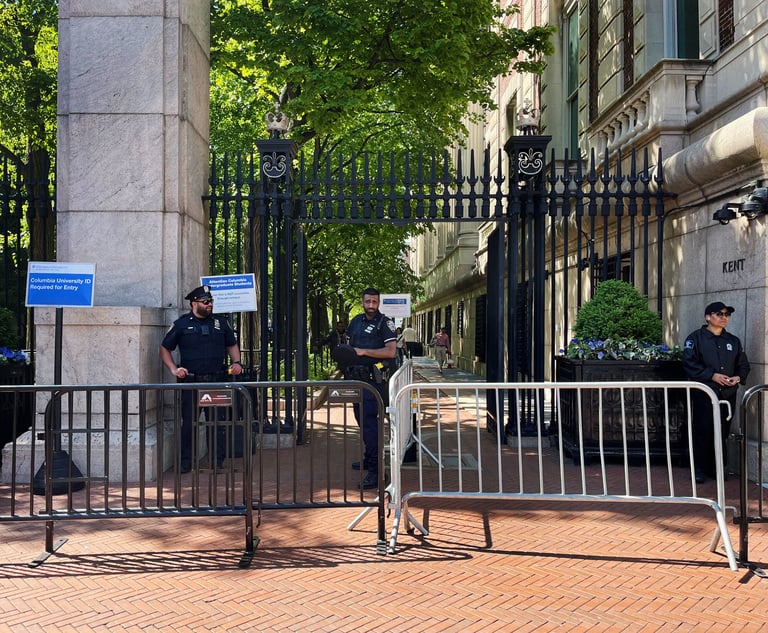Ahead of the Curve: Tracking Law Deans
This week's Ahead of the Curve looks at new data on the racial and gender makeup on the nation's law deans. Plus, does the University of Houston's decision to construct a $90 million law campus signal a new era of law school investment?
August 27, 2019 at 11:55 AM
7 minute read
Welcome back to Ahead of the Curve. I'm Karen Sloan, legal education editor at Law.com, and I'll be your host for this weekly look at innovation and notable developments in legal education.
This week I'm looking at brand new data on the gender and ethnicity of current law deans, courtesy of Mississippi College law professor Jim Rosenblatt's Dean's Database, which reveals a few surprises. Next I'm checking in on the University of Houston Law Center's newly approved $90 million law campus, which could signal a new era of investment in law school facilities. Read on!
Please share your thoughts and feedback with me at [email protected] or on Twitter: @KarenSloanNLJ

Parsing the Dean Ranks
Regular readers of this briefing will know that I've been tracking the rise of women and minority law deans in recent years—a trend that has picked up steam throughout 2018 and 2019. So I was naturally excited when Jim Rosenblatt, himself a former law dean at Mississippi College School of Law,contacted me last week to let me know that he had expanded his always useful law deans database to add gender and ethnicity fields. One of my ongoing frustrations has been a lack of official, up-to-date info on the percentage of women and minority deans out there, and about a year ago I suggested to Rosenblatt that he add those categories to his database, which tracks the longevity of law school deanships and the law schools from which deans obtained their J.D.s. So this is my chance to give a big thank you to Jim for responding to my pleas, and I suggest anyone interested in the topic go to the site and explore the data.
Here are some of the highlights:
➤➤38% of current deans are women—a figure that's even higher than I realized. (I thought it was about a third.)
➤➤26% are minorities. Among them: 15% are African American; 7% are Hispanic; 3% are Asian/Pacific Islander; and 1% are Native American.
➤➤More than a quarter of the 200 or so law deans graduated from either Harvard Law School or Yale Law School, which is a figure unlikely to surprise anyone familiar with the legal academy and its obsession with pedigree.
➤➤The average tenure of current law deans is just over 3.5 years. (The average tenure for completed deanships is just over 5 years.)
Rosenblatt told me that he sees a marked difference in the makeup of law deans in 2019 than when he became a law dean in 2003—most notably the rise of women and minorities in the job. That change has accelerated in the past two years, so I asked Rosenblatt why. Here's what he said:
"I'm not sure there is a precise reason, but I think [women and minorities] are increasing in the base from which deans are drawn. As you have faculty members who become more senior and serve as associate or assistant deans, that's one of the primary pools from which deans are drawn. As they become better known in those roles, they're a natural source to be selected as the top person in the law school."
It stands to reason that the shortening length of the average deanship is also creating more opportunities for the women and minority faculty rising up through the ranks. More turnover at the top means more chances to throw their hats into the ring.
While the dominance of Harvard and Yale in producing future deans isn't news, I want to look a little closer at the alma mater data that Rosenblatt has compiled. According to his numbers, eight law schools have produced nearly half of all current law deans. Harvard and Yale are at the top of that list with 32 and 21 alumni deans, respectively. Interestingly, the University of Michigan Law Schoolties Columbia Law School with 10 apiece, followed by Stanford Law School with nine. Georgetown University Law Center, the University of Chicago Law School; and the University of Virginia School of Law round out the top eight with five deans each. My thoughts: I think it's great to see more women and minorities ascending to lead law schools. It sends a strong message to students and faculty that times are changing and that structural barriers are beginning to fall. But that shouldn't obscure the many challenges that remain in fostering truly diverse law campuses and a legal profession. Minorities remain underrepresented on law faculties—particularly among the tenured ranks. Women are still overrepresented among legal writing and clinical positions, which don't generally provide the same security (and pay) that come with doctrinal faculty jobs. So while there is some movement at the top, much work remains to be done.

A Brand New Home for a Houston Law School
There was a time when new law buildings were coming online right and left. And I'm not just talking about a new clinical building here or a renovated library there. I'm talking about fully new law campuses replacing outdated ones.
The rub is that most of those major building projects were launched or approved before the 2008 recession that sent the law school applicant pool into a seven-year downward spiral from which it's only beginning to recover. (There are a few exceptions, notably Arizona State University Sandra Day O'Connor College of Law and the University of South Carolina School of Law.) For the most part, university administrators appeared wary about launching expensive new buildings at a time when legal education's future seemed uncertain.
So it was refreshing to see last week that the University of Houston System's Board of Regents approved $78 million to fund the construction of a replacement for the University of Houston Law Center's 50-year old building. The entire project will cost $90 million, and the law school has until November to raise the remaining $12 million. (Anyone want a law campus named after them?) Part of the problem for the law school is that more than half of the current law building is underground, which poses major flooding risks. It sustained damage during Hurricanes Ike and Harvey. And the new digs will have all the modern technological bells and whistles that the current campus lacks. Here's what law dean Leonard Baynes had to say about the project:
"A world class institution in a world class city requires a world class building, and we are now on a clear path to making this vision happen. I am delighted that the decades-long aspiration for a new building is becoming a reality. A new Law Center building will be a game changer for the Law Center and enhance the recruitment of students, faculty and staff."
The school aims to break ground in 2021, so here's hoping that everything goes according to plan. Perhaps this is a signal that university bigwigs are once again comfortable in investing the big bucks in their law schools. (Or it's just a sign that folks at the University of Houston were tired of having their law school fill up with water.)
|
Extra Credit Reading
Recent law graduates are generally pleased with their law school's career services offices, though most say their job search required more effort than they expected.
The California Supreme Court has launched its own investigation into the July bar exam debacle, in which the State Bar of California inadvertently disclosed essay topics to a handful of law dean, prompting the bar to then tell all exam takers.
Atticus Finch goes to law school. No, really.
Becoming a Uniform Bar Exam jurisdiction had little impact on test taker results in New York, study finds.
Thanks for reading Ahead of the Curve. Sign up for the newsletter and check out past issues here.
I'll be back next week with more news and updates on the future of legal education. Until then, keep in touch at [email protected]
This content has been archived. It is available through our partners, LexisNexis® and Bloomberg Law.
To view this content, please continue to their sites.
Not a Lexis Subscriber?
Subscribe Now
Not a Bloomberg Law Subscriber?
Subscribe Now
NOT FOR REPRINT
© 2024 ALM Global, LLC, All Rights Reserved. Request academic re-use from www.copyright.com. All other uses, submit a request to [email protected]. For more information visit Asset & Logo Licensing.
You Might Like
View All



Trending Stories
- 1Bankruptcy Judge to Step Down in 2025
- 2Justices Seek Solicitor General's Views on Music Industry's Copyright Case Against ISP
- 3Judge to hear arguments on whether Google's advertising tech constitutes a monopoly
- 4'Big Law Had Become Too Woke': Why Bill Barr Moved On
- 5Manhattan U.S. Attorney Damian Williams Announces Resignation from Office
Who Got The Work
Michael G. Bongiorno, Andrew Scott Dulberg and Elizabeth E. Driscoll from Wilmer Cutler Pickering Hale and Dorr have stepped in to represent Symbotic Inc., an A.I.-enabled technology platform that focuses on increasing supply chain efficiency, and other defendants in a pending shareholder derivative lawsuit. The case, filed Oct. 2 in Massachusetts District Court by the Brown Law Firm on behalf of Stephen Austen, accuses certain officers and directors of misleading investors in regard to Symbotic's potential for margin growth by failing to disclose that the company was not equipped to timely deploy its systems or manage expenses through project delays. The case, assigned to U.S. District Judge Nathaniel M. Gorton, is 1:24-cv-12522, Austen v. Cohen et al.
Who Got The Work
Edmund Polubinski and Marie Killmond of Davis Polk & Wardwell have entered appearances for data platform software development company MongoDB and other defendants in a pending shareholder derivative lawsuit. The action, filed Oct. 7 in New York Southern District Court by the Brown Law Firm, accuses the company's directors and/or officers of falsely expressing confidence in the company’s restructuring of its sales incentive plan and downplaying the severity of decreases in its upfront commitments. The case is 1:24-cv-07594, Roy v. Ittycheria et al.
Who Got The Work
Amy O. Bruchs and Kurt F. Ellison of Michael Best & Friedrich have entered appearances for Epic Systems Corp. in a pending employment discrimination lawsuit. The suit was filed Sept. 7 in Wisconsin Western District Court by Levine Eisberner LLC and Siri & Glimstad on behalf of a project manager who claims that he was wrongfully terminated after applying for a religious exemption to the defendant's COVID-19 vaccine mandate. The case, assigned to U.S. Magistrate Judge Anita Marie Boor, is 3:24-cv-00630, Secker, Nathan v. Epic Systems Corporation.
Who Got The Work
David X. Sullivan, Thomas J. Finn and Gregory A. Hall from McCarter & English have entered appearances for Sunrun Installation Services in a pending civil rights lawsuit. The complaint was filed Sept. 4 in Connecticut District Court by attorney Robert M. Berke on behalf of former employee George Edward Steins, who was arrested and charged with employing an unregistered home improvement salesperson. The complaint alleges that had Sunrun informed the Connecticut Department of Consumer Protection that the plaintiff's employment had ended in 2017 and that he no longer held Sunrun's home improvement contractor license, he would not have been hit with charges, which were dismissed in May 2024. The case, assigned to U.S. District Judge Jeffrey A. Meyer, is 3:24-cv-01423, Steins v. Sunrun, Inc. et al.
Who Got The Work
Greenberg Traurig shareholder Joshua L. Raskin has entered an appearance for boohoo.com UK Ltd. in a pending patent infringement lawsuit. The suit, filed Sept. 3 in Texas Eastern District Court by Rozier Hardt McDonough on behalf of Alto Dynamics, asserts five patents related to an online shopping platform. The case, assigned to U.S. District Judge Rodney Gilstrap, is 2:24-cv-00719, Alto Dynamics, LLC v. boohoo.com UK Limited.
Featured Firms
Law Offices of Gary Martin Hays & Associates, P.C.
(470) 294-1674
Law Offices of Mark E. Salomone
(857) 444-6468
Smith & Hassler
(713) 739-1250








